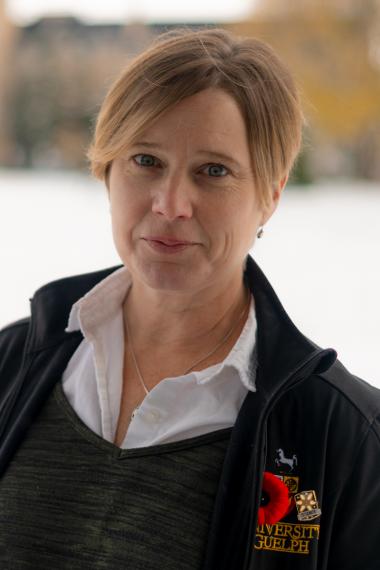Joanne M. O’Meara

Find Related People by Keyword
Education and Employment Background
Dr. Joanne O’Meara received her PhD from McMaster University in 1999. She went on to work as a postdoctoral associate at the Massachusetts Institute of Technology, and as a Visiting Scientist at the Body Composition Laboratory at the USDA Human Nutrition Research Center on Aging at Tufts University. In September 2001, she became an Assistant Professor at McMaster University in the Medical Physics and Applied Radiation Sciences department. O’Meara joined the Department of Physics at the University of Guelph in July 2002, where she is now a full Professor. O’Meara continues to hold adjunct faculty status at McMaster University.
Research Themes
O’Meara’s research focuses on the design of x-ray fluorescence (XRF) systems to measure elemental body composition in vivo. In general, such measurement systems are developed for assessing exposure of industrial populations in the workplace, as the existing monitoring techniques do not provide direct information regarding levels in biologically relevant tissues/organs, tending instead to rely on the inference of worker health from measuring levels in blood and urine. Key research themes include:
- Optimal design of in vivo x-ray fluorescence systems. O’Meara has developed a Monte Carlo photon transport code, and in collaboration with Physics department colleagues Iain Campbell and Ralf Gellert, she has modified this code to investigate the effect of water content in minerals on the Compton-to-coherent scattering ratio detected when probed with an x-ray source. The original Monte Carlo simulation has been expanded to include a host of additional elements, and variance reduction techniques have been introduced to increase the computing speed of the code. O’Meara is continuing to refine this Monte Carlo code, adding surface layers to better model the new water-bearing compounds being measured experimentally. In addition, O’Meara is adding full modeling of interactions in the collimators and the detector.
- Water content of soils and rocks encountered by the Spirit rover on Mars. Typical basaltic surface soils were found to be essentially dry (<1% water by weight) and basaltic rocks were similarly low in water content (<3.5 % water by weight). However, four bright subsurface soils in Gusev Crater were found to have water content in the range of 6 to 18 per cent by weight. These soils also contain extremely high sulfur levels relative to other soils in the region. Together with constraints from mineralogy, O’Meara’s findings indicate that highly hydrated ferric sulfates are important carriers of bound water in these four locations.
- Elemental body composition. In collaboration with colleagues at McMaster University, O’Meara has recently acquired a new system for measuring strontium in bone, and the team will be exploring its use for monitoring patients being treated for osteoporosis with a compound that contains strontium.
Highlights
- Co-founder, Royal City Science. Royal City Science is a registered charity that brings together scientists, educators, and enthusiasts in the city of Guelph with the mission of enhancing the interactive, educational and entertaining science programming available in the community. Our ultimate goal is to build our very own science centre that is accessible to all.
- 3M National Teaching Fellow, 3M/Society for Teaching and Learning in Higher Education (STLHE), 2019
- Member of Science Teachers’ Association of Ontario Secondary Curriculum Committee, 2017-present
- STEM Week coordinator, Guelph Civic Museum, 2018, 2019
- Associate Editor, Canadian Journal of Physics, 2017-2019
- Editor, Science Corner, Guelph Mercury, 2017-2019
- Medal for Excellence in Undergraduate Teaching, Canadian Association of Physicists, 2011
Media Coverage
COVID-19
- Physics World: Physics in the pandemic: ‘Welcome to my new role as university professor, housekeeper, cafeteria lady, school teacher…’
Honors and Awards
- U of G, Physics: Legendary Professor Joanne O'Meara honoured by Classical Mythology class
- Society for Teaching and Learning in Higher Education: 2019 3M National Teaching Fellows
- Macleans: Introducing the 2019 3M National Teaching Fellowship Award Winners
- U of G, University Affairs: Announcements – March 2019
Science Outreach/Events
- CTV News Kitchener: Video series hopes to ignite girls' passion for science
- U of G: Physicist Working to Keep Girls Science-Curious
- PhysicsWorld: Ask me anything: Joanne O'Meara - 'there is nothing better than sharing your passion for science and seeing it ignite in someone else'
- U of G, Physics: AMASE: How Do Straws Work?
- U of G, Physics: AMASE: Why Do We See Stars?
- U of G, Physics: Guelph Physics Launches AMASE!
- U of G, Physics: STEM Week 2019 Round Up
- U of G, Physics: STEM Week Featured on CTV Kitchener
Science Corner
- Guelph Mercury Tribune: Biomimicry — design inspired by nature
- Guelph Mercury Tribune: Could RoboBees be the solution to the declining bee population?
- Guelph Mercury Tribune: 'Slow as molasses' is not even close to an apt description for this experiment
- Guelph Mercury Tribune: Drop Me A Line — the incredible properties of spider silk
- Guelph Mercury Tribune: Platypus milk: saving lives one drop at a time
- Guelph Mercury Tribune: Canadian nanotechnology helping to improve Canada’s game
- Guelph Mercury Tribune: Tardigrades: the most indestructible animal on Earth
- Guelph Mercury Tribune: How a Canadian team found the long-lost ships of the Franklin expedition
- Guelph Mercury Tribune: Peregrine falcons are a marvel of engineering